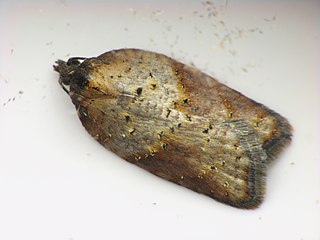
The Tortricidae are a family of moths, commonly known as tortrix moths or leafroller moths, in the order Lepidoptera. This large family has over 11,000 species described, and is the sole member of the superfamily Tortricoidea, although the genus Heliocosma is sometimes placed within this superfamily. Many of these are economically important pests. Olethreutidae is a junior synonym. The typical resting posture is with the wings folded back, producing a rather rounded profile.

Arotrophora is a genus of tortrix moth. They occur in Australia, where they are strongly associated with the plant family Proteaceae. All of the known Australian larvae bore in Banksia flower spikes. The genus was recently discovered from the Oriental region and one species is found on Papua.

The Tortricinae are the nominate subfamily of tortrix moths. Commonly referred to as leafrollers, as the larvae build shelters by folding or rolling leaves of the food plant, the tortricinae include several notable pests as well species used as biological control agents against invasive weeds.

Cryptophlebia is a genus of moths belonging to the subfamily Olethreutinae of the family Tortricidae. It occurs in all biogeographical regions except for the Nearctic.
Leguminivora is a genus of moths belonging to the subfamily Olethreutinae of the family Tortricidae.
Asterolepis is a genus of moths belonging to the subfamily Tortricinae of the family Tortricidae.
Paraphyas is a genus of moths belonging to the subfamily Tortricinae of the family Tortricidae. It contains only one species, Paraphyas callixena, which is found in Australia, where it has been recorded from Western Australia and Tasmania. The habitat consists of wet sclerophyll forests.
Symphygas is a genus of moths belonging to the subfamily Tortricinae of the family Tortricidae. It contains only one species, Symphygas nephaula, which is found in Australia, where it has been recorded from Tasmania. The habitat consists of subalpine open forests at altitudes between 950 and 1,100 meters.

Cryptophlebia ombrodelta, the litchi fruit moth or macadamia nut borer, is a moth of the family Tortricidae. The species was first described by Oswald Bertram Lower in 1898. It is native to India, Sri Lanka, Nepal, Indonesia, China, Taiwan, Vietnam, Thailand, western Malaysia, New Guinea, the Philippines, Japan, Guam, the Caroline Islands, Australia and has been introduced to Hawaii.

The Tortricini are a tribe of tortrix moths.

The Bactrini are a tribe of tortrix moths.

Tirathaba rufivena, the coconut spike moth, greater coconut spike moth or oil palm bunch moth, is a moth of the family Pyralidae. It is found from south-east Asia to the Pacific islands, including Malaysia, the Cook Islands, the Philippines and the tropical region of Queensland, Australia. They are considered as a minor pest.

Homona mermerodes is a species of moth of the family Tortricidae first described by Edward Meyrick in 1910. It was described from the Solomon Islands, but is also found in Australia (Queensland), New Guinea and Seram. The habitat consists of bamboo, secondary forests and alluvial forests.
Epiphyas aulacana is a species of moth of the family Tortricidae. It is found in Australia, where it has been recorded from Lord Howe Island, New South Wales, South Australia, Victoria and Tasmania. The habitat consists of open forests where it has been recorded at altitudes between sea level and 300 meters in Tasmania.
Epiphyas flebilis is a species of moth of the family Tortricidae. It is found in Australia, where it has been recorded from Tasmania. The habitat consists of wet eucalypt and mixed forests.
Ericodesma concordana is a species of moth of the family Tortricidae. It is found in Australia, where it has been recorded from New South Wales, the Australian Capital Territory and Tasmania. The habitat consists of open forests and heathland.
Ericodesma indigestana is a species of moth of the family Tortricidae. It is found in Australia, where it has been recorded from New South Wales, Victoria and Tasmania. The habitat consists of heathland and open treeless areas.
Syllomatia pertinax is a species of moth of the family Tortricidae. It is found in Australia, where it has been recorded from New South Wales and Victoria.
Syllomatia pirastis is a species of moth of the family Tortricidae. It is found in Australia, where it has been recorded from South Australia and Tasmania. The habitat consists of open forests.
Marianne Horak is a Swiss-Australian entomologist who specialises in Australian Lepidoptera, particularly the phycitine and tortricid moths, and is considered one of the worldwide leading experts on the systematics of Tortricidae.








